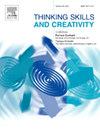Assessing creativity in early childhood: How future teachers balance conformity and originality
IF 4.5
2区 教育学
Q1 Social Sciences
引用次数: 0
Abstract
Creativity is an essential skill in contemporary education systems, particularly in early childhood, where it is stimulated by exploratory activities and the expression of thought through the creation of ideas or the production of new objects. However, its assessment remains a major challenge, particularly for future teachers, who have to reconcile the emergence of creativity with the requirements of training plans. This dual injunction reveals a hesitancy on the part of professionals regarding the definition of creativity and the ways in which its manifestations in students can be assessed.
This study explores how future teachers of early childhood integrate evaluation criteria measuring the development of creativity into their evaluation documents. It aims to understand which dimensions of the creative process and theoretical models, such as the 3Ps and the OECD Creative Assessment Grid, are mobilised in an evaluative context. Two hypotheses guided this work: (1) trainee teachers give priority to technical and observable dimensions, often to the detriment of the creative process, and (2) transversal aspects, such as originality and collaboration, are underrepresented.
To test these hypotheses, 153 evaluation documents produced by student teachers at the HEP Vaud were analysed using a specific grid. The study combined an analysis of proportions, correlations and a hierarchical classification of evaluation criteria.
The results reveal that emphasis is placed on technical and methodological criteria, such as respect for constraints and diversity of materials, while less tangible dimensions, such as originality and collaboration, are marginally taken into account. These trends reflect the systemic challenges involved in assessing creativity that is non-linear and exploratory in nature in early childhood. These initial elements are in line with previous research which emphasises the predominance of observable and measurable aspects of the evaluation of creativity, to the detriment of the creative process, which is more complex to identify. The study also highlights a preference for assessing individual performance to the detriment of more collaborative dynamics. This observation highlights the need to reassess the way in which creativity is understood and taught in teacher training programmes.
In conclusion, this research highlights the importance of equipping future teachers with tools to assess both tangible outcomes and intangible processes, paving the way for a balanced and effective approach to promoting creativity in young learners in a rapidly changing educational landscape.
评估幼儿创造力:未来教师如何平衡一致性和独创性
创造力是当代教育系统的一项基本技能,特别是在幼儿时期,探索活动和通过创造想法或制作新物品来表达思想可以激发创造力。然而,评估仍然是一项重大挑战,特别是对未来的教师来说,他们必须协调创造力的出现与培训计划的要求。这一双重禁令揭示了专业人士对创造力的定义以及评估学生创造力表现的方式的犹豫。本研究探讨未来幼儿教师如何将衡量创造力发展的评估标准整合到他们的评估文件中。它的目的是了解创造性过程的哪些维度和理论模型,如3p和经合组织创造性评估网格,在评估环境中被动员起来。两种假设指导了这项工作:(1)实习教师优先考虑技术和可观察维度,这往往会损害创造性过程;(2)横向方面,如独创性和协作,代表性不足。为了验证这些假设,使用一个特定的网格分析了沃州HEP学生教师制作的153份评估文件。该研究结合了比例分析、相关性分析和评价标准的分层分类。结果表明,重点放在技术和方法标准上,例如对限制和材料多样性的尊重,而不太具体的方面,例如独创性和协作,则被边缘化。这些趋势反映了评估儿童早期非线性和探索性创造力所面临的系统性挑战。这些初始元素与先前的研究一致,强调了创造性评估中可观察和可测量方面的优势,损害了创造性过程,这是更复杂的识别。该研究还强调了对个人绩效评估的偏好,这不利于更多的合作动力。这一观察结果突出表明,有必要重新评估在教师培训方案中理解和教授创造力的方式。总之,这项研究强调了为未来教师提供评估有形成果和无形过程的工具的重要性,为在快速变化的教育环境中促进年轻学习者创造力的平衡和有效方法铺平了道路。
本文章由计算机程序翻译,如有差异,请以英文原文为准。
求助全文
约1分钟内获得全文
求助全文
来源期刊

Thinking Skills and Creativity
EDUCATION & EDUCATIONAL RESEARCH-
CiteScore
6.40
自引率
16.20%
发文量
172
审稿时长
76 days
期刊介绍:
Thinking Skills and Creativity is a new journal providing a peer-reviewed forum for communication and debate for the community of researchers interested in teaching for thinking and creativity. Papers may represent a variety of theoretical perspectives and methodological approaches and may relate to any age level in a diversity of settings: formal and informal, education and work-based.
 求助内容:
求助内容: 应助结果提醒方式:
应助结果提醒方式:


